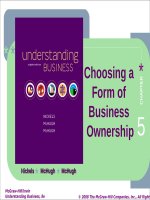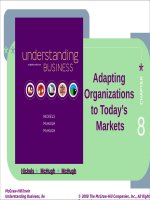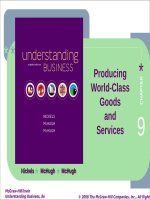Understanding business 11th by mchugh nickels chap012
Bạn đang xem bản rút gọn của tài liệu. Xem và tải ngay bản đầy đủ của tài liệu tại đây (1.03 MB, 52 trang )
CHAPTER 12
Dealing with
Union and
EmployeeManagement
Issues
McGraw-Hill/Irwin
Copyright © 2015 by the McGraw-Hill Companies, Inc. All rights reserved.
LEARNING OBJECTIVES
1. Trace the history of organized labor in the United
States
2. Discuss the major legislation affecting labor unions
3. Outline the objectives of labor unions
12-2
LEARNING OBJECTIVES
4. Describe the tactics used by labor and management
during conflicts, and discuss the role of unions in the
future
5. Assess some of today’s controversial employee–
management issues, such as executive
compensation, pay equity, child care and elder care,
drug testing, and violence in the workplace
12-3
DEMAURICE SMITH
NFL Players Association
• Earned his law degree in 1989
and gained a reputation as a
dedicated trial lawyer.
• He was elected director of the
NFL Players Association in
2009.
• Shortly after starting the job he
was thrown right into the middle
of the recent NFL lockout.
12-4
NAME that COMPANY
The late management consultant Peter Drucker
suggested that CEOs should not earn more than
20 times the salary of the company’s lowest-paid
employee. Most firms ignore his suggestion but
at our company, executive pay is capped at 19
times the average employee’s salary. Still, we
are one of the fastest growing companies in the
United States.
Name that company!
12-5
ORGANIZED LABOR
LO 12-1
• Unions -- Employee organizations whose main goal
is to represent members in employee-management
negotiations of job-related issues.
• Labor unions were responsible for:
- Minimum wage laws
- Overtime rules
- Workers’ compensation
- Severance pay
- Child-labor laws
- Job-safety regulations
12-6
PUBLIC SECTOR
LABOR UNIONS
LO 12-1
• Public sector union members work for
governments as teachers, firefighters, police
officers, etc.
• Many states face serious debt problems and want
to cut labor costs. But states with public sector
unions have limited ability to cut those costs.
• The Governor of Wisconsin challenged public
sector labor unions by eliminating union
bargaining rights for state and public employees.
12-7
GOALS of ORGANIZED LABOR
LO 12-1
• To work with fair and
competent
management.
• To be treated with
human dignity.
• To receive a reasonable
share of wealth in the
work it generates.
12-8
HISTORY of
ORGANIZED LABOR
LO 12-1
• Craft Union -- An organization of skilled specialists
in a particular craft or trade.
• As early as 1792, shoemakers in a Philadelphia
craft union met to discuss fundamental work
issues.
• Work weeks were 60+
hours, wages were low and
child labor was rampant.
12-9
The FACTORY BLAZE that
FIRED UP a MOVEMENT
• On March 25, 1911, 146 women
were killed in a fire at the Triangle
Shirtwaist Company in New York
City.
• The women were trapped by a
door that was kept locked to
prevent theft.
• Today labor leaders say that the
Triangle fire is proof of why labor
unions are crucial to maintaining
workplace balance in the U.S.
12-10
EMERGENCE of LABOR
ORGANIZATIONS
LO 12-1
• Knights of Labor -- First national labor union
(formed in 1869).
• Knights attracted 700,000 members, but fell
from prominence after a riot in Chicago.
• American Federation of Labor (AFL) -- An
organization of craft unions that championed
fundamental labor issues (formed in 1886).
12-11
INDUSTRIAL UNIONS
LO 12-1
• Industrial Unions -- Labor unions of unskilled or
semiskilled workers in mass production industries.
• Congress of Industrial Organizations (CIO) -Union organization of unskilled workers; broke away
from the AFL in 1935 and rejoined in 1955.
• The AFL-CIO today has affiliations with 56 unions
and has about 12.5 million members.
12-12
PUBLIC UNIONS
LO 12-1
• For the first time in U.S. history, 7.2 million of the
14.5 union members work in government.
• Taxpayers, not stockholders, are paying the cost
of union workers wages and benefits.
• The huge state and local government revenue
losses caused by the economic crisis put
pressure to reduce wage and benefit costs.
12-13
EFFECTS of LAWS on
LABOR UNIONS
LO 12-2
• Labor unions’ growth and influence has been very
dependent on public opinion and law.
• The Norris-LaGuardia Act helped unions by
prohibiting the use of Yellow-Dog Contracts -- A
type of contract that required employees to agree to
NOT join a union.
• Collective Bargaining -- The process whereby
union and management representatives form an
agreement, or contract, for employees.
12-14
COLLECTIVE BARGAINING
and the PUBLIC SECTOR
LO 12-2
• Collective bargaining among public union workers
has become a key issue today.
• One of the issues is the fact that public
employees are paid by the taxpayers.
• When it is perceived that public employees are
winning more or better health care, more or better
hours of work, and so on, some have questioned
whether or not such negotiations should be
allowed to continue.
12-15
FORMING a UNION in the
WORKPLACE
LO 12-2
• The National Labor Relations Board (NLRB) was
created to oversee labor-management issues and
provide guidelines for unionization.
• Certification -- The formal process by which a
union is recognized by the NLRB as the bargaining
agent for a group of employees.
• Decertification -- The process whereby employees
take away a union’s right to represent them.
12-16
WHY JOIN a UNION?
LO 12-2
• Pro-union attitudes
• Poor management/employee
relations
• Negative organizational
climate
• Poor work conditions
• Union’s reputation
• Job security
12-17
LABOR/MANAGEMENT
AGREEMENTS
LO 12-3
• Negotiated Labor-Management Agreement
(Labor Contract) -- Sets the terms under which
labor and management will function over a period of
time.
• Union Security Clause -- Stipulates workers who
reap union benefits must either join the union or pay
dues to the union.
12-18
UNION SECURITY AGREEMENTS
LO 12-3
• Closed Shop Agreement -- Specified workers had
to be members of a union before being hired for a job.
• Union Shop Agreement -- Declares workers don’t
have to be members of a union to be hired, but must
agree to join the union within a specific time period.
• Agency Shop Agreement -- Allows employers to
hire nonunion workers who don’t have to join the
union, but must pay fees.
12-19
UNION SECURITY AGREEMENTS
LO 12-3
12-20
RIGHT-to-WORK LAWS
LO 12-3
• Right-to-Work Laws -- Legislation that gives
workers the right, under an open shop, to join or not to
join a union.
• The Taft-Hartley Act of 1947 granted states the
power to outlaw union shop agreements.
• Open Shop Agreement -- Agreement in right-towork states that gives workers the right to join or not
join a union, if one exists in their workplace.
12-21
RIGHT-to-WORK STATES
LO 12-3
12-22
RESOLVING DISAGREEMENTS
LO 12-3
• Labor contracts outline labor and management’s
rights, and serves as a guide to workplace
relations.
• Grievances -- A charge by employees that
management isn’t abiding by the terms of the
negotiated agreement.
• Shop Stewards -- Union officials who work
permanently in an organization and represent
employee interests on a daily basis.
12-23
USING MEDIATION and
ARBITRATION
LO 12-3
• Bargaining Zone -- The range of options between
initial and final offers that each side will consider
before negotiations dissolve or reach an impasse.
• Mediation -- The use of a third party (mediator) to
encourage both sides to keep negotiating to resolve
key contract issues.
• Arbitration -- An agreement to bring in a third party
to render a binding agreement.
12-24
The GRIEVANCE RESOLUTION
PROCESS
LO 12-3
12-25









